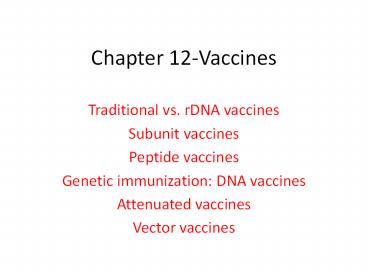Chapter 12-Vaccines - PowerPoint PPT Presentation
1 / 14
Title:
Chapter 12-Vaccines
Description:
Chapter 12-Vaccines Traditional vs. rDNA vaccines Subunit vaccines Peptide vaccines Genetic immunization: DNA vaccines Attenuated vaccines Vector vaccines – PowerPoint PPT presentation
Number of Views:237
Avg rating:3.0/5.0
Title: Chapter 12-Vaccines
1
Chapter 12-Vaccines
- Traditional vs. rDNA vaccines
- Subunit vaccines
- Peptide vaccines
- Genetic immunization DNA vaccines
- Attenuated vaccines
- Vector vaccines
2
Traditional vaccines and their drawbacks
- Traditional vaccines are either inactivated or
attenuated infectious agents (bacteria or
viruses) injected into an antibody-producing
organism to produce immunity - Drawbacks include inability to grow enough
agent, safety concerns, reversion of attenuated
strains, incomplete inactivation, shelf life may
require refrigeration
3
How do you make a traditional vaccine?
Seehttp//www.influenza.com/Index.cfm?FAScience_
History_6 For information about H1N1 Flu (Swine
Flu), see http//www.cdc.gov/H1N1FLU/
4
Recombinant DNA technology can create better,
safer, reliable vaccines
- Immunologically active, non-infectious agents can
be produced by deleting virulence genes - A gene(s) encoding a major antigenic
determinant(s) can be cloned into a benign
carrier organisms (virus or bacteria) - Genes or portions of genes encoding major
antigenic determinants can be cloned in
expression vectors and large amounts of the
product purified and used as a subunit or peptide
vaccine, respectively
5
Table 12.2 Some human disease agents for which
rDNA vaccines are being developed
6
Fig. 12.1 Typical animal virus structure
Note capsid and envelope proteins can elicit
neutralizing antibodies
7
Influenza (Flu) virus structure
See http//micro.magnet.fsu.edu/cells/viruses/inf
luenzavirus.html
8
Fig. 12.2 A subunit vaccine against HSV
Secreted gD protein
HSV
Transfected CHO cell
Cloned viral gD gene
Purify conc.
Infect
Infect
Inject
Not protected
Protected!
9
A similar approach was used to create a subunit
vaccine against foot-and-mouth disease virus
(FMDV) and Human Papillovmavirus (HPV)
- FMDV has a devastating effect on cattle and swine
- The successful subunit vaccine is based on the
expression of the capsid viral protein 1 (VP1) as
a fusion protein with the bacteriophage MS2
replicase protein in E. coli - The FMDV genome consists of a 8kb ssRNA a cDNA
was made to this genome and the VP1 region
identified immunologically (see Fig. 12.4) - A subunit vaccine (Gardasil) was developed
against Human Papillomavirus this virus causes
genital warts and is associated with the
development of cervical cancers used the capsid
proteins from four HPVs
10
Fig. 12.11 Structure of a peptide vaccine,
representing yet another rDNA approach
Linker
Carrier Protein
Short peptides
11
Fig. 12.15 Genetic immunization DNA vaccines
represent another rDNA approach
Microparticle
Plasmid (with gene encoding the antigenic protein
under the control of an animal virus promoter)
A biolistic system or direct injection is used to
introduce this DNA microparticle into animals
12
Table 12.3 Advantages of genetic immunization
over traditional vaccines
- Culturing of dangerous infectious agents is
avoided - No chance to revert to virulence
- Avoid any side effects of attenuated vaccines in
young or old (immunocompromised) animals - Production is inexpensive since there is no need
to produce or purify protein - Storage is inexpensive since DNA is stable
- One plasmid could encode several
antigens/vaccines or several plasmids could be
mixed and administered simultaneously
13
Attenuated vaccines
- Attenuated vaccines traditionally use
nonpathogenic bacteria or viruses related to
their pathogenic counterparts - Genetic manipulation may also be used to create
attenuated vaccines by deleting a key disease
causing gene from the pathogenic agent - Example the enterotoxin gene for the A1 peptide
of V. cholerae, the causative agent of cholera,
was deleted the resulting bacterial was
non-pathogenic and yet elicits a good
immunoprotection (some side effects noted however)
14
Vector vaccines
- Here the idea is to use a benign virus as a
vector to carry your favorite antigen gene from
some pathogenic agent - The vaccinia virus is one such benign virus and
has been used to express such antigens - Properties of the vaccinia virus 187kb dsDNA
genome, encodes 200 different proteins,
replicates in the cytoplasm with its own
replication machinery, broad host range, stable
for years after drying - However, the virus genome is very large and lacks
unique RE sites, so gene encoding specific
antigens must be introduced into the viral genome
by homologous recombination (see Fig. 11.16)































